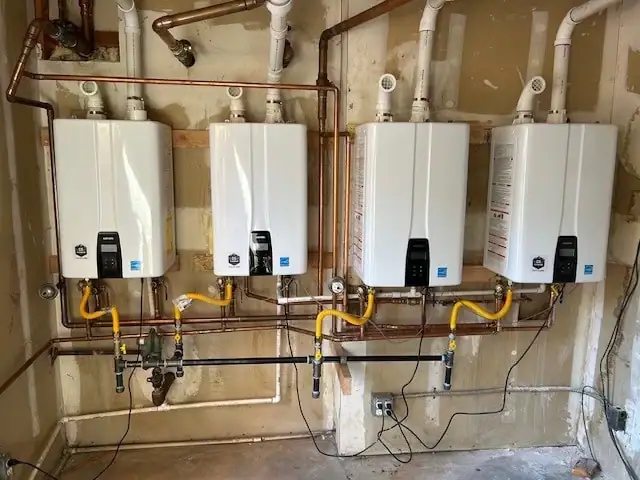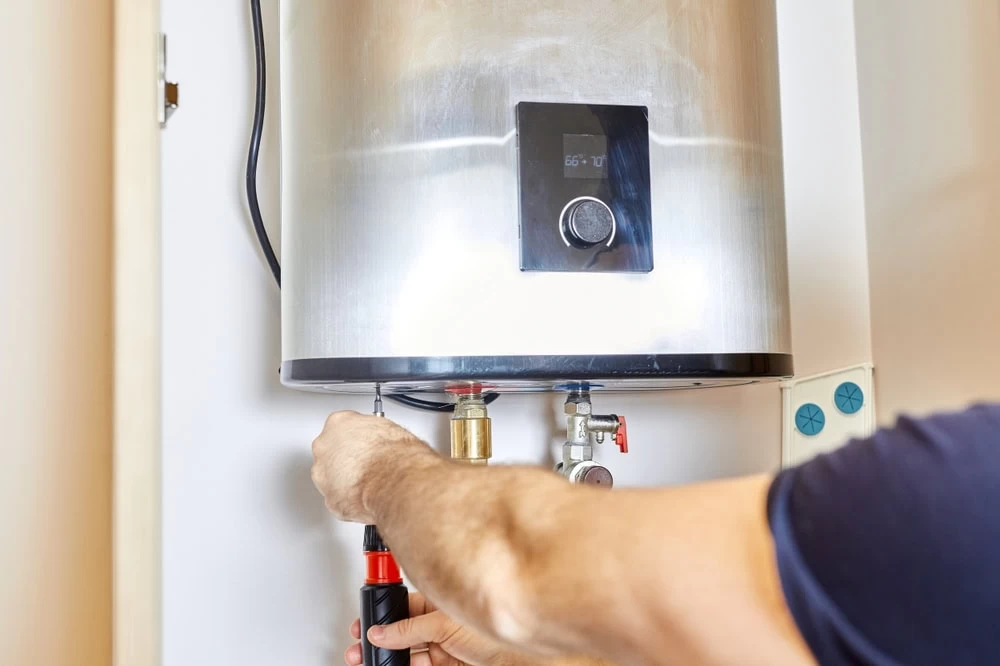Discover the five most dangerous water heater installation mistakes that California homeowners make and how professional installation protects your family and investment.
Share:

Summary:
Water heater installation isn’t just about connecting pipes and plugging in power. It involves gas lines, electrical connections, building codes, and safety systems that protect your family from serious harm. When these systems fail, the consequences can be devastating.
In 2007 alone, water heaters caused 7,200 house fires, resulting in $75 million in property damage, 340 injuries, and 30 deaths. Most of these incidents stemmed from improper installation or maintenance. California’s strict building codes exist for good reason—they prevent these tragedies from happening in your home.
The complexity of modern water heater systems means even small mistakes can have major consequences. From carbon monoxide poisoning to explosions, the risks of DIY installation far exceed any potential savings.

Poor venting is one of the most dangerous water heater installation mistakes, especially with gas units. When your water heater isn’t properly vented, deadly carbon monoxide can build up in your home instead of safely exiting through the vent system.
Carbon monoxide is an invisible, odorless gas that forms when fuels like natural gas don’t burn completely. When you breathe it in, it displaces oxygen in your bloodstream, causing headaches, dizziness, nausea, and in severe cases, death. Proper ventilation to the outside is absolutely crucial to prevent this life-threatening scenario.
Many DIY installations fail because homeowners don’t understand that gas water heaters require specific vent sizing based on the unit’s BTU output and the length of the vent run. Using the wrong vent materials or improper installation creates dangerous backdrafting, where exhaust gases return into your home instead of safely exiting.
California’s building codes mandate proper venting systems to prevent carbon monoxide leaks, but many homeowners skip this critical step or install it incorrectly. Professional emergency plumbers understand these requirements and have the tools to test proper ventilation after installation. They know that single-wall vents need 6-inch clearance from combustibles, while B-vent systems only require 1-inch clearance.
Don’t risk your family’s safety by guessing at vent requirements. Professional installation ensures your system meets all safety standards and protects your loved ones from this silent killer.
The pressure relief valve might look like a small, insignificant component, but it’s actually a critical safety device that prevents your water heater from exploding. Unfortunately, it’s one of the most commonly overlooked or incorrectly installed parts during DIY installations.
This valve automatically releases excess pressure from your water heater tank. If it’s not installed properly—or worse, not installed at all—pressure can build up inside the tank until it ruptures or explodes. When this happens, anyone within a few feet of the tank gets drenched in scalding water, and the explosion can cause serious property damage.
The valve must be installed directly into the designated opening on the tank without any shutoff valves between them. The discharge pipe must point downward and terminate within 6 inches of the floor to prevent scalding injuries if it activates. Many DIY installations place the valve incorrectly, use the wrong pipe materials, or fail to connect a proper drain tube.
California building codes require proper installation of temperature and pressure relief lines to avoid excessive internal pressure on the tank. Professional plumbers know these requirements and have the experience to install relief valves correctly. They understand that this isn’t just about following code—it’s about preventing potentially deadly accidents.
Never cap, plug, or modify the pressure relief valve, as it’s essential for preventing dangerous pressure buildup. If you’re unsure about any aspect of relief valve installation, call a professional. The cost of proper installation is minimal compared to the potential damage from an improperly installed or missing relief valve.
Want live answers?
Connect with a CG Plumbing expert for fast, friendly support.
California has some of the strictest building codes in the nation, and water heater installation, CA falls under these regulations for good reason. Ignoring these requirements doesn’t just risk safety—it can void your insurance, result in hefty fines, and create problems when you sell your home.
Most municipalities require permits for water heater installations, and skipping this step can cost you hundreds of dollars per day in fines. These permits ensure your installation meets current codes and receives proper inspection. Without them, you’re not just breaking the law—you’re putting your family and property at risk.
Professional installers understand local code requirements and handle the permitting process as part of their service. They know what inspectors look for and ensure your installation passes on the first try.

Many homeowners think they can skip permits for water heater replacement, but this decision can have serious long-term consequences. California law requires permits for most water heater installations, and attempting DIY installation without proper permits is risky business.
When you’re caught installing without a permit—and you likely will be when you try to sell your home—you could face fines of hundreds of dollars per day in some areas. These fines add up quickly and can far exceed the cost of professional installation. Even worse, unpermitted work can void your homeowners’ insurance coverage, leaving you financially exposed if something goes wrong.
Permits aren’t just bureaucratic red tape—they ensure your installation meets safety standards and local building codes. The inspection process catches dangerous mistakes before they become costly problems. Inspectors verify proper venting, correct electrical connections, adequate clearances, and compliance with seismic safety requirements.
Professional plumbing contractors handle the permitting process as part of their service, and many include permit costs in their installation fees. They know exactly what documentation is required, how to schedule inspections, and what inspectors expect to see. This expertise ensures your installation passes inspection the first time, avoiding delays and additional costs.
California’s emergency permitting guidelines allow permits to be pulled after installation in urgent situations, but this doesn’t eliminate the requirement. Licensed plumbers know how to navigate this process quickly and correctly, ensuring your installation is legal and safe.
California’s location in an active earthquake zone makes seismic strapping absolutely essential, yet many DIY installations ignore this critical safety requirement. State law mandates that all water heaters must be properly anchored to resist falling during seismic events, but proper installation is more complex than most homeowners realize.
Seismic strapping requires two metal straps: one around the top third of the tank and another around the bottom third. These straps must be securely fastened to wall studs—not just drywall—using appropriate hardware. The water heater should be positioned within two inches of the wall to prevent backward tipping during an earthquake.
Many DIY installations use inadequate strapping materials, place straps incorrectly, or fail to secure them to structural elements. Poor strapping can allow the unit to tip during an earthquake, potentially rupturing gas lines or water connections and creating fire or flood hazards. This isn’t just about code compliance—it’s about protecting your family and property during seismic events.
Professional installers understand California’s specific seismic requirements and have the proper materials and hardware for secure installation. They know how to locate wall studs, select appropriate strapping materials, and position units correctly to meet safety standards.
The cost of proper seismic strapping is minimal compared to the potential damage from an unsecured water heater during an earthquake. Don’t gamble with your family’s safety—ensure your water heater installation meets California’s seismic safety requirements through professional installation.
Water heater installation mistakes aren’t just inconvenient—they’re dangerous and expensive. From carbon monoxide poisoning to voided warranties, the risks of DIY installation far outweigh any potential savings. Professional installation protects your family, preserves your warranty coverage, and ensures code compliance.
The average water heater replacement costs $2,500 in California, but the cost of fixing installation mistakes can be much higher. When you factor in potential fines, insurance issues, and safety risks, professional installation becomes the smart financial choice.
At CG Plumbing, we understand the complexity of California’s building codes and safety requirements. Our licensed, background-checked technicians handle every aspect of installation, from permits to final inspection, ensuring your water heater operates safely and efficiently for years to come.
Article details:
Share: